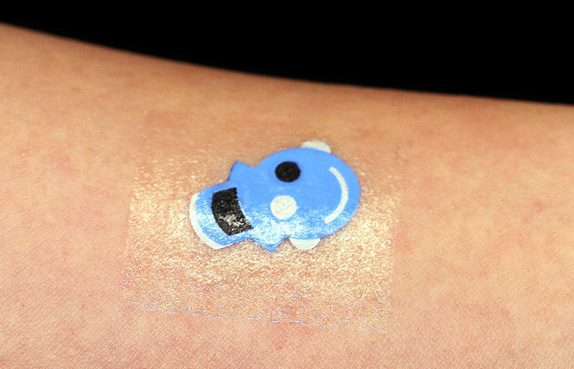Getting ‘inked’: lactate “tattoo” to gauge intensity of training

First of all, the tattoo is only temporary, so all you needle-phobes can stop squirming. It’s actually a bio-sensor that sticks to your skin and its purpose is to measure the levels of lactate in your sweat.
Lactate is a by-product of physical activity and an indicator of your exercise intensity — a.k.a. how hard you’re working. When you exercise at a low or moderate level, your body is able to clear/eliminate all the lactate that is formed and you can continue indefinitely. But when you exercise at sufficiently high intensities and the amount of lactate produced exceeds what the body can clear, it accumulates and leads to fatigue (exactly how we still don’t know).
A popular training pace is termed the ‘lactate threshold,’ which equates to the pace/running speed that can be maintained without accumulating excessive lactate. As a general rule, your lactate threshold is the pace you can sustain for about an hour. For many, that’s somewhere between your 10K and 10 mile race pace.
Currently, the only way to accurately measure lactate levels during training is to take blood samples at multiple points during exercise, which is both cumbersome and invasive. Imagine getting a finger prick blood sample done every minute for 10+ minutes during a hard training run. Not terribly appealing.
But now, the lactate tattoo may make measuring lactate during training a simple, painless and much more accessible method of gauging exercise intensity. The researchers who developed the tattoo have published their findings in the journal Analytical Chemistry and showed that the levels measured from the tattoo were accurate when compared with levels determined via those nasty blood samples.
Although the technology is not yet available for commercial use, its implications for training have become highly anticipated, with many already praising the tattoo for its potential to revolutionize how we train for endurance events. Much like the heart rate monitor before it, the lactate tattoo could soon be a fundamental training tool for both elites and amateurs alike.
So why should we be excited?
In short, by knowing exactly at what intensity we are running at, our effort (i.e. running speed/pace) can be altered, up or down, to induce a desired training response. By running at, or slightly above, our lactate threshold pace, we train the body to be more efficient in how it deals with excessive lactate and over time the threshold can gradually be improved. Alternatively, we can also know when we are running below our threshold, which is essential when we want to recover or stimulate enhanced endurance. By running below the threshold, we safely avoid training too hard (i.e. overtraining).


